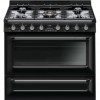Smeg TRU36GGBL User Guide - Page 19
Cooking advice
 |
View all Smeg TRU36GGBL manuals
Add to My Manuals
Save this manual to your list of manuals |
Page 19 highlights
EN Use 2.7 Cooking advice General advice • Use a convection function to achieve consistent cooking at several levels. • It is not possible to shorten cooking times by increasing the temperature (the food could be overcooked on the outside and undercooked on the inside). Advice for cooking meat • Cooking times vary according to the thickness and quality of the food and to consumer taste. • Use a meat thermometer when roasting meat, or simply press on the roast with a spoon. If it is hard, it is ready; if not, it needs another few minutes cooking. Advice for cooking with the Broiler and the Convection broil • Meat can be grilled even when it is put into the cold oven or into the preheated oven if you wish to change the effect of the cooking. • With the Convection broil function, we recommend that you preheat the oven before grilling. • We recommend placing the food at the center of the rack. • Foods should be seasoned before cooking. Foods should also be coated with oil or melted butter before cooking. • Use the oven tray on the first bottom shelf to collect fluids produced by grilling. • Grilling processes should never last more than 60 minutes. Advice for cooking desserts/pastries and cookies • Use dark metal baking pans/sheets: they help to absorb the heat better. • The temperature and the cooking time depend on the quality and consistency of the dough. • To check whether the dessert is cooked right through: at the end of the cooking time, put a toothpick into the highest point of the dessert. If the dough does not stick to the toothpick, the dessert is cooked. • If the dessert collapses when it comes out of the oven, next time reduce the set temperature by about 10°C (50°F), selecting a longer cooking time if necessary. • While cooking desserts or vegetables, excessive condensation may form on the glass. In order to avoid this, open the door very carefully a couple of times while cooking. 21















